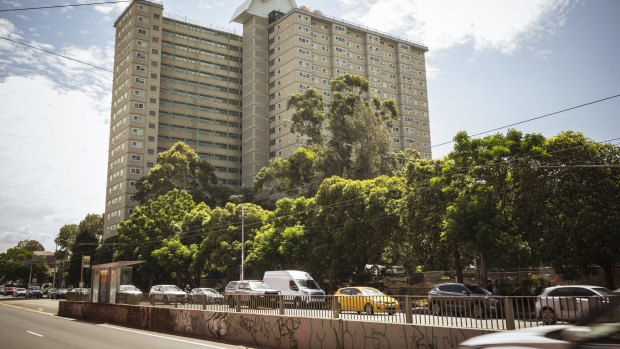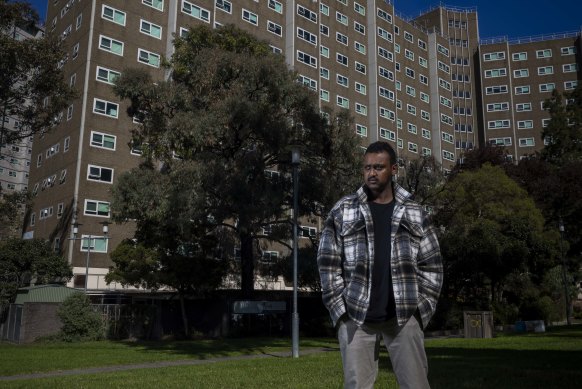This was published 1 year ago
Public housing towers class action case dismissed, but judge throws lifeline
By Rachael Dexter
The legal fight against the demolition of Melbourne’s high-rise public housing towers has been dealt a major blow after the Supreme Court revealed on Friday it would dismiss the class action brought on behalf of hundreds of tenants.
The state government has also indicated it will pursue the lead plaintiff – a public housing resident of 26 years – for its costs related to the case, a suggestion that shocked lawyers for the tenants.

One of the first public housing towers set for demolition at Holland Street in Flemington.Credit: Chris Hopkins
Justice Melinda Richards told the court on Friday that she would summarily dismiss the class action case because she did not accept one of the key pillars of the legal arguments put by lawyers for the residents relating to cabinet’s authority to greenlight the plan.
But she left the door open for a new class action trial to go ahead if they were able to reframe their argument at a later date.
Announced as a key part of the state’s landmark housing package last September, then-premier Daniel Andrews promised that all 44 high-rise towers dotted across inner Melbourne would be razed and rebuilt to fit three times as many residents over the next 30 years.
The class action was launched in January this year on behalf of tenants of the first three occupied towers slated for demolition – 33 Alfred Street and 120 Racecourse Road in North Melbourne, and 12 Holland Street in Flemington – led by lead plaintiff, youth worker and community leader Barry Berih.
Berih has been a vocal critic of the state government in the past, including of the harsh lockdown of nine public housing towers at the height of the COVID-19 pandemic’s second wave. He was involved in a previous class action for residents related to the lockdowns.
The lawyers for the tenants had argued that Andrews’ announcement of the redevelopment in his government’s Housing Statement (a policy document signed off by cabinet) was invalid because only Homes Victoria (formerly the Director of Housing) had the power under Housing Act to redevelop the land and move tenants.
But Richards suggested Homes Victoria – not cabinet – should be at the centre of the case, given it had the power to act on the decision to demolish the towers.
“There is something of a missing middle [in the case],” she told the court. “Yes, of course, cabinet made the decision but it is being clearly implemented [by Homes Victoria].”

Barry Berih is a youth worker and public tenant at the North Melbourne public housing estate.Credit: Wayne Taylor
The decision came after the government applied to have the case dismissed. The government’s barrister, Liam Brown, SC, said it would seek costs from the residents for the dismissal application, given it was successful.
Asked to explain the decision to pursue costs against Berih, a state government spokeswoman said that as the matter was before the courts, “it would be inappropriate to comment”.
Berih said residents found out about the tower demolitions from a press conference on TV.
“Some of the residents have been there for more than 30 years, we’re a family, we’re a community. That’s the reason why I went for it,” Berih said outside court on Friday. “It just felt very, very heartbreaking, basically, and just the way the government announced it was very bad.”
Richards did not give detailed reasons for dismissing the case, saying she would publish them at a later date and hold off on determining costs.
Of the 484 residents captured in the class action, 427 have already signed relocation agreements and some have already moved out.
Dates set aside for a trial mid-year are still in place. Richards will hand down her decision and reasoning on the summary dismissal next Friday.
The second argument in the class action was that the government failed to properly consider the human rights of residents when it decided to redevelop the towers.
Inner Melbourne Community Legal lawyer Louisa Bassini claimed the news on Friday was “not a setback at all”.
“We’re seeking to have residents who live in these towers provided with an opportunity to hear the reasons for the decision to demolish the towers and we haven’t yet been provided that,” she said.
“So for us now, it will be a case of reframing our arguments somewhat, but returning to put the argument again.”
Responding to the suggestion the state would seek costs from the public housing residents, Bassini said: “I think it gives an indication that the government is reluctant to allow accountability of its decision-making in this instance and it is disappointing.”
Lawyers for the tenants had flagged they would bring in architects as expert witnesses at trial to give evidence on how the buildings could be retrofitted instead of demolished, preventing the upheaval of the community.
About 30,000 people would live at the estates by 2051 under the knockdown-rebuild plan – with 11,000 in social housing, about 1000 more than occupy the towers now. The remainder would be private apartments, with an unspecified number of so-called “affordable” housing tenants.
While some residents have expressed an interest in new facilities, citing the rundown conditions at some towers, others have joined public protests against the plan.
Critics of the plan say it would upend the lives of thousands of vulnerable residents – an unfair trade-off for a 10 per cent increase in the number of social housing units. Others hold concerns about watered-down tenants’ rights under a community housing model.
The future of the case will be decided on May 31, when it comes back before the court.
– With AAP
Get the day’s breaking news, entertainment ideas and a long read to enjoy. Sign up to receive our Evening Edition newsletter here.